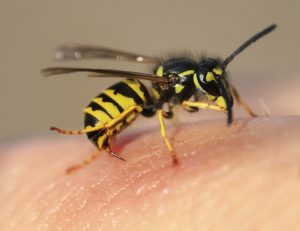It is summertime and we all spend more time outdoors. Whether it be in our gardens, the park, or at the beach, the potential to get bitten by a bee is always there.
Bees are typically attracted to flowers because of their scent and bright colors. They can be attracted to a human if they are wearing brightly colored clothing or have a particular scent.
Getting stung by a bee is not the most pleasant experience to say the least. In the event that you are stung by a bee here are a few helpful steps to follow:
- Remove the stinger as soon as you can, as it only takes seconds for the venom to enter your body. You can remove the stinger by scraping it off the best way you can. (example: fingernail, tweezer, credit card ).
- Wash the sting area with soap and water.
- Apply cold compresses or ice to relieve pain and ease swelling.
The treatment steps for minor reactions to bee stings are not as effective for those who have severe allergic reactions. If you are allergic to bee stings, contact your primary care provider or seek emergency medical care immediately. Severe reactions may need epinephrine, by way of an Epi-Pen.
If you are stung by a bee, you should seek medical attention as quickly as possible if you are having any sort of reaction.
All content of this newsletter is intended for general information purposes only and is not intended or implied to be a substitute for professional medical advice, diagnosis or treatment. Please consult a medical professional before adopting any of the suggestions on this page. You must never disregard professional medical advice or delay seeking medical treatment based upon any content of this newsletter. PROMPTLY CONSULT YOUR PHYSICIAN OR CALL 911 IF YOU BELIEVE YOU HAVE A MEDICAL EMERGENCY.

